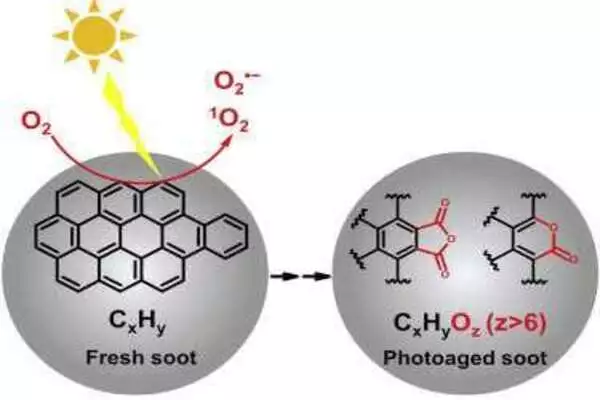The photochemical oxidation of polycyclic aromatic hydrocarbons on soot in particle phase can result in a significant amount of highly unsaturated and oxygenated organic aerosol. This alters soot’s ability to serve as cloud condensation nuclei and influences its climate impact, according to the findings of a new study led by Yafang Cheng of the independent Minerva Research Group ‘Aerosols, Air Quality, and Climate’ at the Max Planck Institute for Chemistry in Mainz.
Highly oxygenated organic molecules are an important component of secondary organic aerosol in the atmosphere. The origin and mechanism of highly oxygenated organic molecules with high unsaturation (HU-HOMs) are, however, unknown. However, an international team of researchers has discovered that photooxidation of large polycyclic aromatic hydrocarbons (PAHs) on soot by singlet oxygen and superoxide anion radicals can be a significant source of the widely observed HU-HOMs in the atmosphere.
The team was led by Yafang Cheng from the Max Planck Institute for Chemistry and Chuncheng Chen from the Institute of Chemistry, Chinese Academy of Sciences. Their results are based on molecular-level investigations of the photochemical aging of soot by O2. The PAH-derived HU-HOMs exhibit lactone and anhydride functional groups and can substantially increase the hydrophilicity of soot.
In this heterogeneous photochemical oxidation, O2 molecules are the initial oxidant, which is further photosensitized to form reactive oxygen species such as singlet oxygen and superoxide anion radicals. Considering the abundance of O2 in the troposphere, this oxidation pathway should be a very important aging process for PAHs and soot particles, especially in clean and remote regions.
The increase in hydrophilicity of soot after photochemical aging is expected to further influence the fate and effects of soot aerosols in the atmosphere, such as making them better cloud condensation nuclei, being more easily involved in aqueous phase chemistry and aging, altering their wet deposition process, and so on.
Cloud seeding is a weather modification technique used to increase cloud precipitation. Cloud precipitation efficiency, defined as the ratio of rain falling to the ground to water vapor entering the cloud base, is frequently well below unity. The idea behind cloud seeding, which was first proposed after World War II, is to artificially increase precipitation efficiency, and despite many scientific uncertainties, it has become a popular activity in many arid regions around the world.

Deciphering the molecular formulae
The researchers used laser desorption ionization coupled with Fourier transform ion cyclotron resonance mass spectrometry (LDI FT-ICR MS), an ultrahigh-resolution mass spectrometry technique that allows confident assignment of molecular formulae, to characterize the evolution of molecular composition during the photoaging of soot. The evolution of functional groups during soot oxidation was studied using in situ attenuated total internal reflection IR (ATR-IR).
They discover that highly oxygenated organic molecules with high unsaturation (HU-HOMs) are formed via a multigenerational photochemical oxidation pathway in which ketones, aldehydes, and acids are produced in the initial stage by photooxidation of large polycyclic aromatic hydrocarbons on soot, followed by the formation and accumulation of lactones and anhydrides on further oxidation.
“In this heterogeneous photochemical oxidation, O2 molecules are the initial oxidant, which is further photosensitized to form reactive oxygen species such as singlet oxygen and superoxide anion radicals,” said Meng Li, postdoc in Yafang Cheng’s group and the first author of the study. “Considering the abundance of O2 in the troposphere, this oxidation pathway should be a very important aging process for PAHs and soot particles, especially in clean and remote regions,” added Meng Li.
“Because of the widespread presence of PAHs, this new HU-HOM formation pathway could be a characteristic evolution pathway of primary organic aerosols from various combustions, contributing to a more comprehensive understanding of the chemical evolution of organic aerosols,” said Yafang Cheng, who leads the Minerva Independent Research Group at the MPIC.





